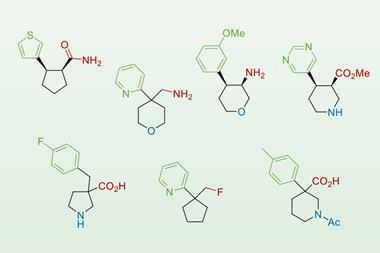How medicinal and process chemists are working together to build better drugs
I’ve spent the last few years of my life making medicines, and I’d highly recommend it. UK pharma is, broadly, a great place to be and many of my past and present colleagues report making a difference to patients’ lives as one of their main driving forces.
But the process isn’t simple at all. Med chemists start small, sometimes with sub-300g per mol molecules called fragments. Fragments are too small to definitively exhibit the physicochemical properties of the drug substance they will grow into. This means they can be rapidly screened against a single objective – effectiveness against the protein target. (In the same vein, they can also be tested for their selectivity – the lack of unwanted effects on other proteins in the body.)
The experimental design simplicity of single-objective optimisation makes it possible to screen a huge variety of fragments, in terms of shape, flexibility, electronic features, hydrogen bonding capabilities and any other molecular design parameters we can choose. This diversity is continually increasing as specialist vendors build catalogues of fragments that enhance coverage into previously unexplored chemical space.
The art of ‘hit to lead’ medicinal chemistry is building this fragment up to a highly efficacious and selective molecule, while restraining its properties within useful ranges, such as ensuring it stays in solution within the human body. We might need to come up with intricate molecular structures to keep the covetable properties high and the unwanted ones to a minimum. Reports show that small molecule drug structures tend to become more complex over time.
Historically, medicinal chemists have placed soft barriers on what we can make as part of a fast-paced medicinal chemistry project. In practice, more synthetically challenging targets are made less frequently, simply because there is a higher chance of reward from making several different compounds rapidly than taking more time to make a single compound – even if it initially seems more promising. Although this unintentionally biases our exploration of chemical space, synthesis challenges occasionally also hint at issues such as compound stability, perhaps under particular conditions such as the low pH of the stomach. And trouble with syntheses can be compounded when it comes time to scale up, in process chemistry.
A map is not very useful if it only shows the hilltops
However, vendor fragment catalogues are filling with motifs such as the cagelike bicyclo[1.1.1]pentanes and 2-azabicyclo[2.1.1]hexanes, and other much more reactive scaffolds, levelling the playing field of synthetic accessibility. With a wide variety of complex units premade by a third party, the risk and time commitment to access them vanishes. But when we scale up, it’s not just the final, single molecule drug target’s safety and reactivity concerns we have to consider – these need to be evaluated for every intermediate between synthetic steps too. As well as needing to ensure the safety of operators running the experiments that use these sometimes strained and energy-rich newer building blocks, particularly reactive motifs have a higher chance of forming toxic impurities in the flask and metabolites in the body, which could render them unusable as a drug.
Medicinal chemists should explore this chemical space regardless. Only a select few of the tens of thousands of compounds made on a project will be scaled up, and experimental safety concerns that become important in process can often be mitigated on the few-hundred-milligram scale. Not every compound is even made with the aim of being incorporated into a drug, as we cannot understand a structure–activity relationship fully with only patches of data. After all, a map is not very useful if it only shows the hilltops without describing the valleys and cliffs between them. So, outside of specific concerns such as toxicity, traditional synthetic accessibility is not explicitly part of designing a good drug substance.
When they do win a place in a final drug candidate molecule, reactive ring systems inject fear into the hearts of process chemists. Conditions that were easy on a small scale become challenging or impossible on plant, and routes must be redesigned to avoid the most dangerous or resource-intensive steps. In the public drug development community, we are even starting to see process chemists pushing back on reactive scaffolds due to the risk they won’t make it through scale-up.
We don’t have access to a perfect drug, though the effort required to make a candidate that enters trials compels you to think that each time, we must be fairly close. I’m definitely excited when I see new building block types – although when skeletal structures start to look like a game of Tetris gone wrong, we might have to pick up the pieces later on. I look forward to decades more of medicinal and process chemists working together to make the best pharmaceuticals!












No comments yet